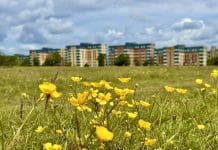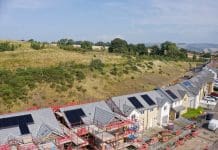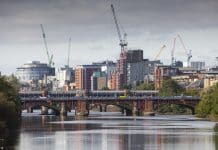People live in houses, not planning permissions. Solving the housing crisis is at least a two-parliament problem, says David Blackadder-Weinstein, Director, Strategic Communications at Turley
As midnight struck on election night, and only the first results were trickling through, in television studios and council buildings across the country, experts, former MPs, and thumb-twiddling parliamentary candidates had time to discuss what the changed Labour government would be able to do with the huge majority that exit polls were rightly suggesting.
The next Deputy Prime Minister, future Chancellor of the Exchequer, and Alastair Campbell were all in agreement about one thing: the planning system is the low hanging fruit which will enable economic growth faster than any other lever available to Sir Keir Starmer and his new cabinet. Angela Rayner, his Deputy and the incoming Secretary of State responsible for housing even reached for the 1.5 million new homes commitment as the cameras rolled expectantly.
Positive planning policy
Never before has the need for positive planning policy been so central to the national discourse. It is not unexpected on either side of the aisle. Labour made New Towns a cornerstone of its campaign strategy, while the Conservatives hoped warnings of a concreted-over countryside might be enough to save some of its more rural seats from being lost to the Liberal Democrats.
If you only used West Midlands Green Belt seats as a bellwether, then the Tory tactic worked a dream. Bromsgrove, Kenilworth & Southam, Meriden & East Solihull, Sutton Coldfield, Aldridge-Brownhills, and Stone, Great Wyrley & Penkridge all returned some of the strongest Conservative majorities left anywhere in the country. Perhaps the “Blue Belt” will be replacing the “Red Wall” as something which needs particular consideration in future elections.
Some built environment sector experts feared a Labour “supermajority” might make economic growth via development harder if Green Belt seats returned Labour MPs who may feel they may have to continue the decades-long trend of frustrating the planning system. However, with a majority of over 170, the Prime Minister and his Chancellor can afford a minor rebellion or two while still easily cutting the red tape that has held back nationwide development. It was not just election night that gave planning a prominent platform. The final weekend before the national vote was characterised by a joint article in the Sunday Times in which Starmer and Reeves promised significant planning reform in their first hundred days in power. The first editorials following the official poll were similarly full of the same promises of a planning blitz, rather than more traditional commitments about the NHS, education, or wider tax and spending plans.
Labour’s New Towns Commission
Green Belt is the most recognisable, but often misunderstood planning policy in British history. It is cherished by some in a similar way to the NHS. By comparison, Labour’s most prominent manifesto commitment to development has been the proposed New Towns Commission and a 1.5 million home housebuilding target for the first parliament. However, being arithmetically the same as the Conservative’s 300,000-homes-a-year target makes the latter less exceptional. It is ironic, but widely unappreciated, that one promise has nothing to do with the other in practice.
As midnight strikes on the next General Election night in 2029, it seems unlikely that a single house will have been occupied in any of Labour’s proposed New Towns. Policy progress in terms of new towns over the next five years will look like the safeguarding of land, the creation of Development Corporations, or at best, the submission of outline planning applications. In fact, these things would represent considerable success in the realisation of significant new towns, which has proved largely unachievable since the wake of the Second World War.
Even if six new towns of 50,000 homes each are identified, together they will likely only deliver 300,000 new homes over the next 40 years at least. If we need at least 300,000 homes a year today, Labour’s New Towns will have little or nothing to do with solving the housing availability and affordability crisis in the short term. No one can live in a planning permission. Labour will need more than plans for new towns to make a dent in reducing housing need.
Changes to the National Planning Policy Framework
Expect promises of fast changes to the National Planning Policy Framework to be delivered on. Expect planning applications that are already in the system to be accelerated and, in some cases, allowed either by planning officers, committees, or appeal even if they are not perfect. Rachel Reeves’ well-documented commitment to supply-side economic stimulus means she will be doing whatever she can to encourage more planning applications, which in turn will create more planning permissions, and only then, more houses people can actually live in. Even this will take at least three or four years and will be characterised by the kind of incremental development which does not deliver much or anything in the way of meaningful infrastructure – schools and doctor’s surgeries.
New towns are a grand and good idea. But smaller scale new communities are often much more deliverable. Many of them are already in the elongated planning pipeline, based around existing railway stations, motorway junctions, or other necessary transport nodes. They may already have allocations or draft allocations in local plans. It is these new communities and villages of between 2,000 and 5,000 homes which do include public infrastructure and can help this new government towards delivering the highest number of annual housing starts since the 1970s, the last time the magical 300,000 figure was reached.
Delivering affordable homes
On the steps of Downing Street Sir Keir Starmer made mention of affordable homes in his first speech as Prime Minister. These should not be delivered in enclaves of low-cost housing but must be part of mixed communities that bring all sorts of people alongside one another in the way that Starmer says he wants to bring the whole country together. The next time dead air is being filled as we wait for votes to be counted, the pundits and candidates will not yet be able to debate how new towns or communities will affect voter turnout or preference. But by 2034 they just might. Solving the housing crisis is at least a two-parliament problem.















As reported earlier in the year, housebuilders have not built 1 in 3 homes they have planning for, why have house building sites slowed down? Simple answer is the house builders aren’t making enough profits on the houses. They slow down the house building, increasing demand, which leads to increased prices for the buyers.
Government needs to do something about the house builders themselves, not just the planning.
Where is all the infrastructure for these new houses?
K Gorman
After over 40 years of dealing with the many iterations of the Planning System and attendant changes, all of which were allegedly in an effort to simplify, improve effectiveness and provide delivery of the right dwellings in the right place in a timely manner , I can only agree with David Blackadder. In all of those 40 plus years, all targets have not been meaningfully achieved. There has been the occasional glimmer of success in the numbers, but they have not withstood closer examination and proven to be more fictional rather than accurate. Members of the public, the electorate, are probably unaware just how long it takes and how much it costs to achieve Planning Permission for major., and even some minor, Developments. We have had cases where the actual build out took far less time than achieving Planning Permission. I fear that David Blackadder’s concerns and opinions should be considered more a prophecy than an opinion.
One listened with great intent to the current Government’s missive on housing targets and delivery over the next five years, with particular reference to how another version of the NPPF, which will only be given an 8 week open consultative period before being seriously considered for publication and implementation, it would seem, will facilitate such an improvement. One can only admire the hubris of Right Honourable Lady’s presentation ,and possibly ambition, to achieve such a spectacular improvement in the housing supply over the life of this Parliament. Perhaps it would be wise to remind those responsible for such ambition of the old epithet ” the devil is always in the detail” …and there will be great deal of detail to consider, certainly more that 8 weeks worth !!